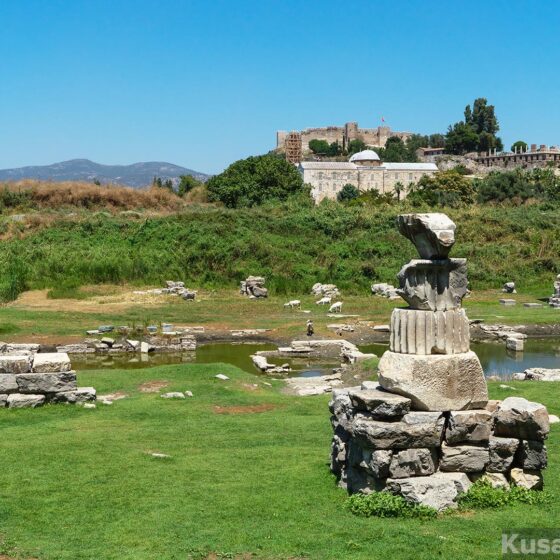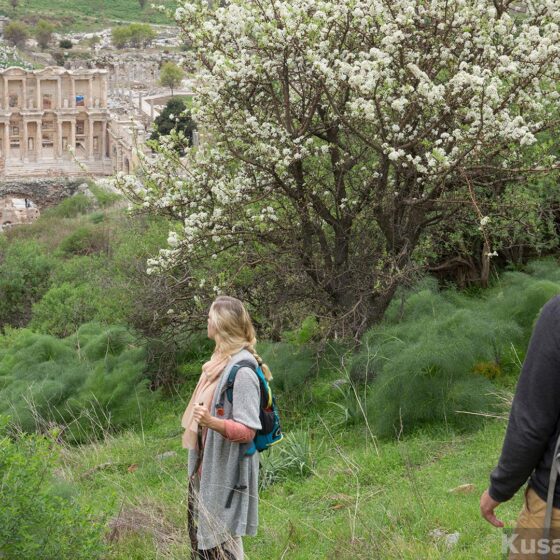Table of Contents Show
Why does Pamukkale’s dazzling white stretch call to you, shimmering like snow under the Turkish sun? How does it weave into the tales of Kusadasi’s coast and Ephesus’s ancient stones? Let me, Alice, answer that. Years ago, I stood on its petrified terraces, the warm pools bubbling at my feet, feeling the link to Ephesus’s marble echoes and Kusadasi’s salty breeze. Pamukkale is a must for its natural beauty and history, just a hop from your Kusadasi stay or Ephesus visit in 2025. Let’s start!
Why Visit Pamukkale
What makes Pamukkale so special? Picture its white limestone terraces, cascading like frozen waterfalls, filled with thermal pools that glow under sunlight. It’s a natural wonder I’ve swooned over, paired with Hierapolis’s Roman ruins—think grand theatres and tombs whispering spa-city tales from 2,000 years ago. You need to see it for that surreal blend; it ties to Ephesus’s ancient pull and Kusadasi’s coastal charm, all part of Turkey’s rich tapestry. The terraces, formed by mineral-rich springs, feel like stepping into a dream, while Hierapolis’s stones echo Ephesus’s grandeur, just a bit wilder. I’ve dipped my toes in those pools, marvelling at the link to a Roman past, and it’s why this spot’s unmissable in 2025.
From Kusadasi to Pamukkale
How do I get to Pamukkale easily from Kusadasi? Let me walk you through it. It’s a two-hour dolmus ride to Denizli, then a quick minibus to the site, or you can book a tour from Kusadasi for comfort—it’s doable in a day. I’ve taken the dolmus, chatting with locals about their spa trips, landing at Pamukkale’s base by late morning. Tours often include a driver and guide, letting you soak in the scenery without stress. My local tip? Leave early to dodge traffic; summer buses fill fast. Note: Check 2025 schedules; some routes now offer direct options, but autumn’s quieter for travel.
From Ephesus to Pamukkale
Can I combine Ephesus and Pamukkale in a day? You bet, and I’ve done it. From Selcuk’s Ephesus ruins, it’s a two-hour drive or tour hop to Pamukkale, linking history’s heartbeat to nature’s art. Many tours start in Kusadasi, swing by Ephesus, then roll to Pamukkale, letting you trace Roman roads to Roman baths. I’ve joined one, marvelling at Ephesus’s Library of Celsus, then soaking in Pamukkale’s pools, feeling the region’s past merge. My local tip? Book a private tour for pace; public transport’s cheaper but slower. Note: Summer heat makes the link tiring; plan an early start and a late return.
What to See and Do
What’s the best pool to swim in at Pamukkale? I’d pick the upper terraces, where warm, mineral-rich water laps at your ankles, offering views of the white cascades below. I’ve waded there, the water silky against skin, feeling centuries of bathers’ echoes. Explore Hierapolis’s theatre, its stone seats still intact, or the necropolis’s eerie tombs—I’ve walked them, imagining Roman spa-goers. Stroll the travertines barefoot for that crunch, or visit the museum for Hierapolis’s artefacts, linking to Ephesus’s relics. I’ve tasted local pide at a nearby stall, watching Kusadasi-style life unfold, making it a full day’s delight.
Practical Tips
What should I pack for Pamukkale? Light clothes for summer’s heat, a hat, and sunscreen—autumn’s cooler, my favourite. Slip-resistant shoes are vital for wet terraces; I’ve slipped once, learning quick. Costs are reasonable; dolmus fares are cheap, tours vary, but bring Turkish lira for extras. Safety’s solid—I’ve roamed freely, but stick to paths on terraces. In 2025, new signs guide visitors, so follow them. My local tip? Buy a bottle of spring water at the base; it’s refreshing and local lore says it’s healing.
Why does Pamukkale deepen your Kusadasi and Ephesus trip? As I sit by Kusadasi’s marina, the sea whispering, I see its white terraces glowing in memory, tying to Ephesus’s stones and the coast’s pulse. It’s not just a day out—it’s nature’s art and history’s whisper, enriching your stay with a splash of wonder.
In 2025, it’s calling; will you answer? x
Last updated on February 27, 2025



